How to Condition Leather Sofa: Easy Tips for a Fresh Look
06.07.25
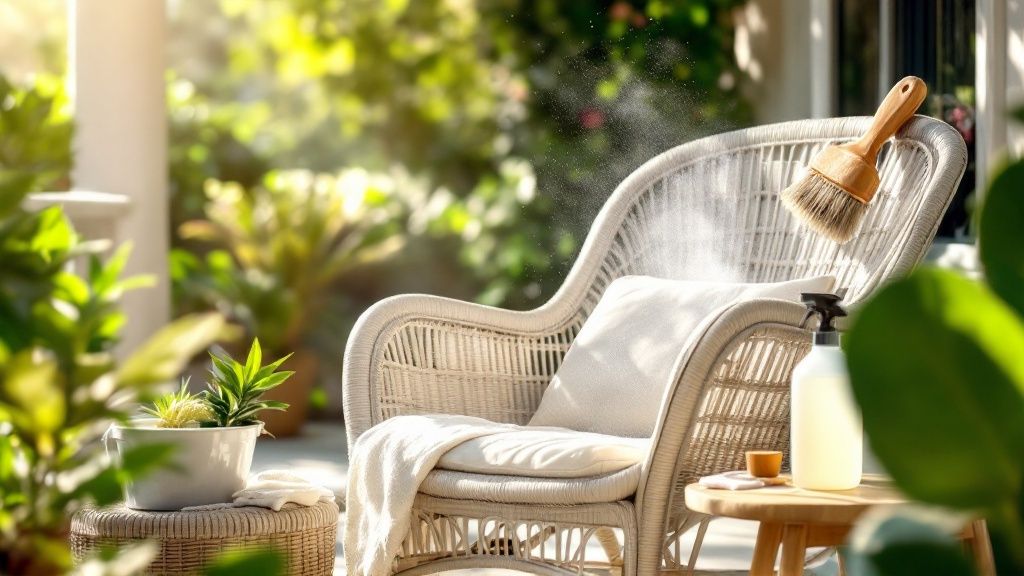
You’re staring at your beautiful wicker furniture, and it’s… not so beautiful anymore. Dust nestled in every weave. Maybe a mystery stain from last summer’s barbecue. And that slight musty smell that makes you wonder if you’ve ruined your investment.
Here’s the thing: Cleaning wicker furniture doesn’t have to be scary. But one wrong move with the wrong cleaner, and yes, you could damage it beyond repair. That’s why we’ve compiled this comprehensive guide based on 25+ years of handling premium wicker pieces at High End Used Furniture.
Whether you’ve got a vintage Ethan Allen wicker set or a modern synthetic piece, this guide will walk you through exactly how to clean wicker furniture safely and effectively. No guesswork. No accidents. Just clean, beautiful furniture.
Before you grab any cleaning supplies, STOP.
The biggest mistake people make? Treating all wicker the same. It’s like washing cashmere with the same intensity as denim. Natural and synthetic wicker are completely different beasts, and using the wrong cleaning method is the fastest way to destroy your furniture.
Think of wicker as falling into two camps:
Natural Wicker:
Synthetic Wicker:
Quick Test: Look closely at the weave. See subtle color differences and texture variations? That’s natural wicker. Perfectly uniform? You’ve got synthetic.
Here’s what happens when you get it wrong:
Natural wicker + too much water = warping, cracking, and mold (nightmare scenario)
Synthetic wicker + gentle cleaning = still dirty furniture (waste of time)
Check out this comparison to see just how different they really are:
| Feature | Natural Wicker | Synthetic Wicker |
|---|---|---|
| Material | Rattan, bamboo, willow | Polyethylene resin |
| Water Tolerance | Low – can warp and crack | High – practically waterproof |
| Cleaning Intensity | Gentle only | Can handle aggressive cleaning |
| Maintenance Needs | High – regular care required | Low – occasional deep clean |
| Visual Appearance | Natural variations | Perfectly uniform |
| Weight | Noticeably lighter | Heavier, more substantial |
Understanding your wicker type isn’t just helpful—it’s essential. Natural wicker requires the gentle touch of someone handling antique lace. Synthetic wicker? You can practically power wash it (though we’ll show you better methods).
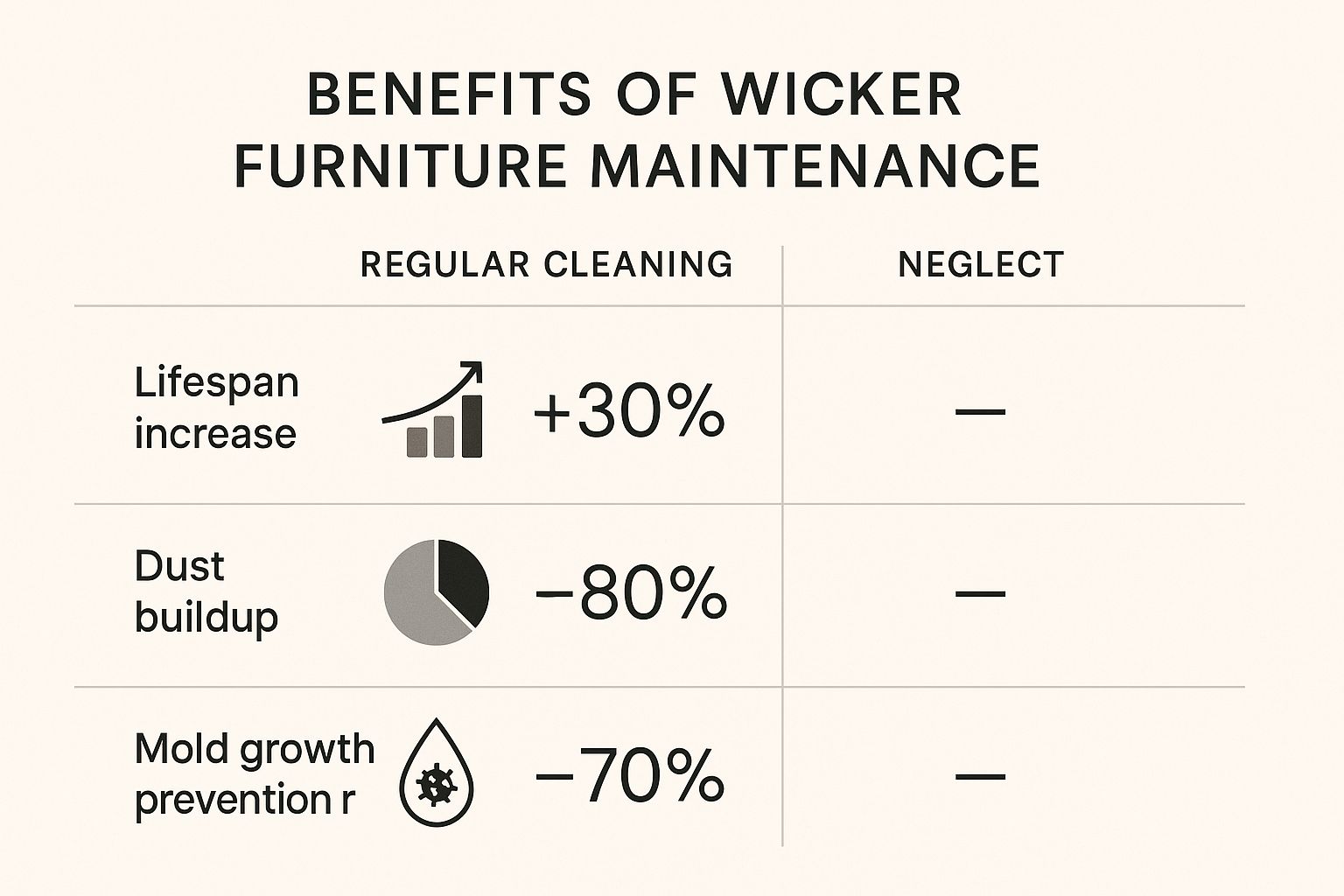
Look at those statistics above. Regular cleaning can extend your wicker’s life by 30%. That’s the difference between furniture that lasts 10 years versus 13 years. Worth the effort? Absolutely.
Interested in quality wicker pieces that are worth maintaining? Browse our curated collection of high-end wicker furniture.
Good news: You probably have 90% of what you need already sitting under your kitchen sink.
After 25 years in the furniture business, we’ve learned that the fanciest cleaning products aren’t always the best. In fact, simple household items often work better than expensive specialty cleaners.
Here’s your wicker-cleaning toolkit:
The Basics:
Pro Tip: That soft brush is crucial. Hard bristles will snag and damage natural wicker fibers. We’ve seen too many beautiful pieces ruined by aggressive scrubbing.
Forget the fancy brand names. Here’s what actually works:
For Natural Wicker:
For Synthetic Wicker:
Save your money and mix these yourself:
All-Purpose Wicker Cleaner:
Stubborn Stain Fighter (Synthetic Only):
Before you start scrubbing:
Looking for furniture worth protecting? Explore our selection of premium used furniture brands including Drexel, Thomasville, and more.
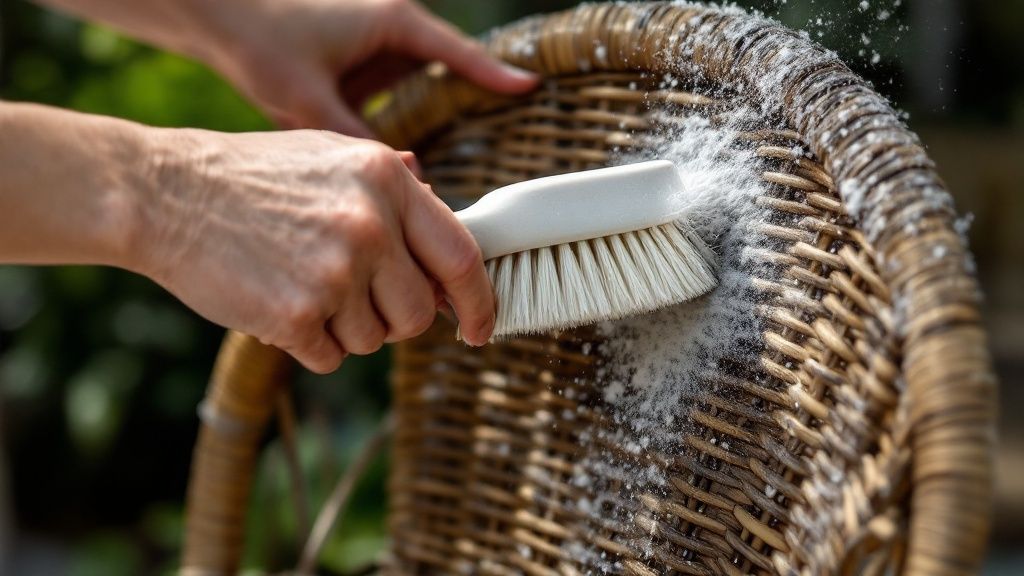
Natural wicker is like that delicate sweater you love—treat it wrong, and it’s ruined forever. But treat it right? It’ll last generations.
Here’s the thing: Most natural wicker damage happens during cleaning, not daily use. Follow these steps, and your furniture will thank you.
Think of dust as wicker’s worst enemy. It settles into every crevice, attracts moisture, and eventually breaks down the fibers.
The Right Way to Dust:
Why This Matters: Regular dusting means you’ll rarely need to deep clean. It’s 5 minutes now or 2 hours later.
When dusting isn’t enough, here’s your game plan:
Critical Rule: Natural wicker should never be soaking wet. Think “barely damp” not “wringing wet.”
Those beautiful woven patterns? They’re dust magnets. Here’s how to clean them:
Drying is just as important as washing when it comes to wicker furniture care. Here’s how to do it right:
Immediate Steps:
Drying Timeline:
Found some mildew? Don’t panic:
Mildew Removal:
For Stubborn Stains:
When to Call It: Some stains aren’t worth the risk. If you’ve tried twice without success, consider professional cleaning. Better safe than sorry with valuable pieces.
Now we’re talking! Synthetic wicker is the tough guy of the wicker world. You can actually clean it without walking on eggshells.
This is where you can break out the big guns (within reason). Synthetic wicker laughs at water, shrugs off mild chemicals, and can handle some serious scrubbing.
Unlike its natural cousin, synthetic wicker can handle:
Real-World Example: Spilled red wine at last night’s dinner party? With synthetic wicker, grab the hose. Problem solved.
This ease of maintenance keeps your furniture looking its best with minimal effort.
When your synthetic wicker needs serious attention:
Yes, you can pressure wash synthetic wicker, but:
Safe Pressure Washing Rules:
Warning: Even synthetic wicker has limits. High pressure at close range will damage the weave. When in doubt, stick to hand cleaning.
Got a piece that looks beyond hope? Try this:
The Deep Clean Method:
Different stains, different strategies:
| Stain Type | Treatment Method | Success Rate |
|---|---|---|
| Food/Grease | Dish soap + warm water | 95% |
| Tree Sap | Rubbing alcohol on cloth | 85% |
| Bird Droppings | Vinegar solution + quick action | 90% |
| Rust from Hardware | Commercial rust remover | 75% |
| Mold/Mildew | Bleach solution (1:10 ratio) | 95% |
The outdoor furniture market hit $8.5 billion in 2020 and is growing 5% annually. Why? Because quality synthetic wicker delivers:
Over 70% of homeowners increased outdoor living time in recent years. Synthetic wicker makes that lifestyle sustainable.
Ready to upgrade your outdoor space? Check out our weather-resistant furniture options.
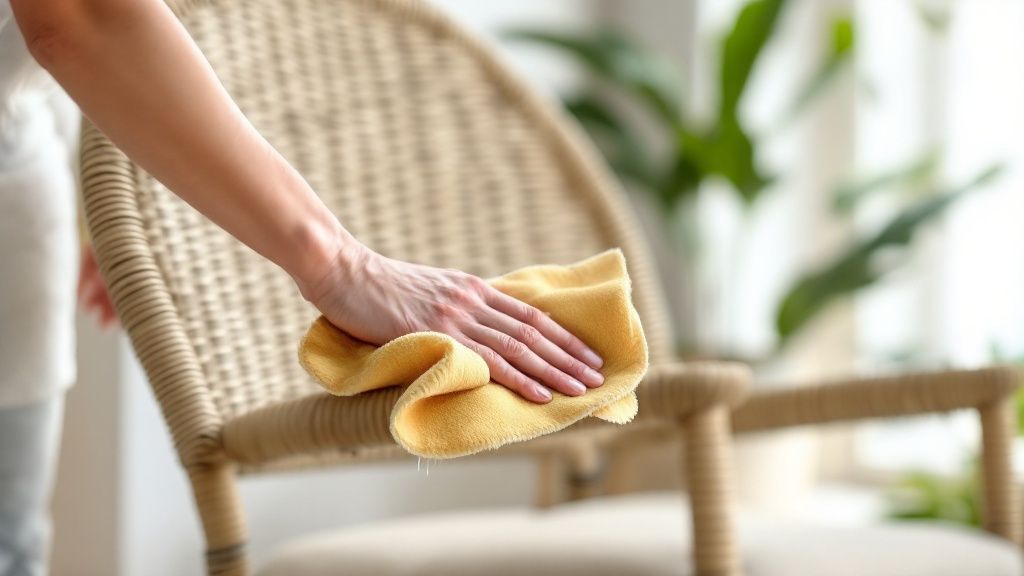
We’ve all been there. That stain that mocks your cleaning efforts. That mysterious spot that appeared overnight. Here’s your game plan for winning these battles.
Not all stains are created equal:
Organic Stains (food, drinks, bird droppings):
Inorganic Stains (rust, paint, adhesive):
Mystery Stains (who knows?):
Before you start, gather these proven solutions:
From Your Pantry:
From Your Medicine Cabinet:
For Fresh Spills (The Golden Hour):
For Set-In Stains:
Red Wine on Natural Wicker:
Bird Droppings (The Patio Plague):
Tree Sap (The Sticky Situation):
| Stain Type | First Action | Best Treatment | Natural Wicker Safe? |
|---|---|---|---|
| Coffee/Tea | Blot + Cold Water | Vinegar Solution | Yes |
| Grease | Absorb with Cornstarch | Dish Soap Mix | Yes |
| Ink | Don’t Spread It | Rubbing Alcohol | Test First |
| Grass | Scrape Excess | Vinegar + Dish Soap | Yes |
| Rust | Don’t Wet | Lemon Juice + Salt | Yes |
| Paint | Act While Wet | Depends on Paint Type | Usually No |
Smart prevention beats any cleaning method:
Sometimes, professional help is the smart choice:
Remember: A professional cleaning costs less than replacing quality furniture. Don’t let pride cost you a treasured piece.
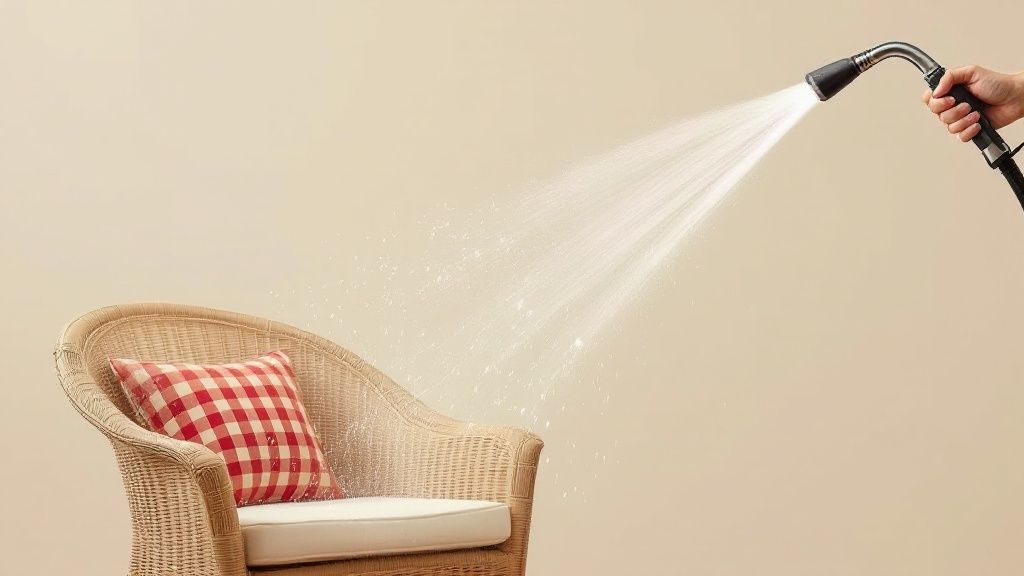
Here’s a truth bomb: 90% of wicker furniture dies from neglect, not use. But with 10 minutes of prevention, you can add years to your furniture’s life.
Think of it like this—you change your car’s oil to avoid engine failure. Same principle here.
These aren’t optional if you want furniture that lasts:
UV Protection Spray:
Waterproofing Treatment:
Application Tip: Always apply protectants to CLEAN, DRY furniture. Sealing in dirt defeats the purpose.
Spring (The Fresh Start):
Summer (The Heavy Use Season):
Fall (The Preparation):
Winter (The Rest Period):
Indoor Storage (The Gold Standard):
Outdoor Storage (When You Must):
Know when DIY isn’t enough:
Call professionals for:
DIY maintenance handles:
Consider these numbers:
The math is simple. Maintenance wins every time.
Interested in furniture worth maintaining? Explore our collection of vintage Ethan Allen and other premium brands.
Let’s get real—you didn’t read this entire guide to let your furniture deteriorate anyway. Here’s your action plan for wicker that lasts.
Every Week:
This simple routine prevents 80% of wicker problems. Set a phone reminder. Thank yourself later.
Spring & Fall (The Big Cleans):
Time Investment: 2 hours twice a year saves furniture worth thousands.
For Busy People:
For Furniture Enthusiasts:
Don’t Ignore These Warning Signs:
🚧 Mold/Mildew Growth
⚠️ Cracking Sounds
🚧 Loose Weaves
⚠️ Persistent Odors
Stock These Essentials:
Total investment: Under $100
Furniture saved: Priceless
The secret to long-lasting wicker? Making maintenance automatic:
You’ve invested in quality wicker furniture. Now invest the minimal time to keep it beautiful. With proper care:
Now that you know how to properly maintain wicker furniture, why not invest in pieces that deserve your attention?
At High End Used Furniture, we hand-select only the finest pre-owned wicker and furniture pieces—the kind worth protecting and passing down. Our 25+ years of experience means we know quality when we see it.
Browse our collection of:
Every piece scores 8/10 or better in condition. Every piece is worthy of the care you’ve just learned to provide.
Questions about caring for a specific piece? Call us at 816-651-6155. We love talking furniture, and we’re here to help you make the most of your investment.
Because great furniture deserves great care.
High end used furniture